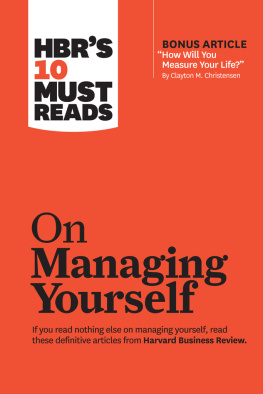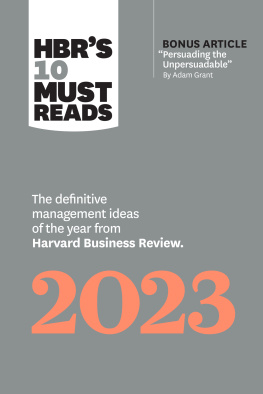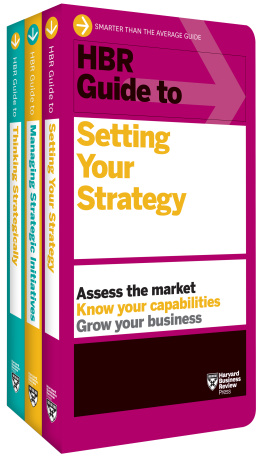Harvard Business Review - The HBR Diversity and Inclusion Collection (5 Books)
Here you can read online Harvard Business Review - The HBR Diversity and Inclusion Collection (5 Books) full text of the book (entire story) in english for free. Download pdf and epub, get meaning, cover and reviews about this ebook. year: 2021, publisher: Harvard Business Review Press, genre: Business. Description of the work, (preface) as well as reviews are available. Best literature library LitArk.com created for fans of good reading and offers a wide selection of genres:
Romance novel
Science fiction
Adventure
Detective
Science
History
Home and family
Prose
Art
Politics
Computer
Non-fiction
Religion
Business
Children
Humor
Choose a favorite category and find really read worthwhile books. Enjoy immersion in the world of imagination, feel the emotions of the characters or learn something new for yourself, make an fascinating discovery.
- Book:The HBR Diversity and Inclusion Collection (5 Books)
- Author:
- Publisher:Harvard Business Review Press
- Genre:
- Year:2021
- Rating:4 / 5
- Favourites:Add to favourites
- Your mark:
- 80
- 1
- 2
- 3
- 4
- 5
The HBR Diversity and Inclusion Collection (5 Books): summary, description and annotation
We offer to read an annotation, description, summary or preface (depends on what the author of the book "The HBR Diversity and Inclusion Collection (5 Books)" wrote himself). If you haven't found the necessary information about the book — write in the comments, we will try to find it.
Harvard Business Review: author's other books
Who wrote The HBR Diversity and Inclusion Collection (5 Books)? Find out the surname, the name of the author of the book and a list of all author's works by series.
The HBR Diversity and Inclusion Collection (5 Books) — read online for free the complete book (whole text) full work
Below is the text of the book, divided by pages. System saving the place of the last page read, allows you to conveniently read the book "The HBR Diversity and Inclusion Collection (5 Books)" online for free, without having to search again every time where you left off. Put a bookmark, and you can go to the page where you finished reading at any time.
Font size:
Interval:
Bookmark:


HBR Diversity and Inclusion Collection
Contents
Harvard Business Review Press
Boston, Massachusetts
HBRs 10 Must Reads series is the definitive collection of ideas and best practices for aspiring and experienced leaders alike. These books offer essential reading selected from the pages of Harvard Business Review on topics critical to the success of every manager.
Titles include:
HBRs 10 Must Reads 2015
HBRs 10 Must Reads 2016
HBRs 10 Must Reads 2017
HBRs 10 Must Reads 2018
HBRs 10 Must Reads 2019
HBRs 10 Must Reads 2020
HBRs 10 Must Reads for CEOs
HBRs 10 Must Reads for New Managers
HBRs 10 Must Reads on AI, Analytics, and the New Machine Age
HBRs 10 Must Reads on Business Model Innovation
HBRs 10 Must Reads on Change Management
HBRs 10 Must Reads on Collaboration
HBRs 10 Must Reads on Communication
HBRs 10 Must Reads on Diversity
HBRs 10 Must Reads on Emotional Intelligence
HBRs 10 Must Reads on Entrepreneurship and Startups
HBRs 10 Must Reads on Innovation
HBRs 10 Must Reads on Leadership
HBRs 10 Must Reads on Leadership for Healthcare
HBRs 10 Must Reads on Leadership Lessons from Sports
HBRs 10 Must Reads on Making Smart Decisions
HBRs 10 Must Reads on Managing Across Cultures
HBRs 10 Must Reads on Managing People
HBRs 10 Must Reads on Managing Yourself
HBRs 10 Must Reads on Mental Toughness
HBRs 10 Must Reads on Negotiation
HBRs 10 Must Reads on Nonprofits and the Social Sectors
HBRs 10 Must Reads on Reinventing HR
HBRs 10 Must Reads on Sales
HBRs 10 Must Reads on Strategic Marketing
HBRs 10 Must Reads on Strategy
HBRs 10 Must Reads on Strategy for Healthcare
HBRs 10 Must Reads on Teams
HBRs 10 Must Reads on Women and Leadership
HBRs 10 Must Reads: The Essentials
HBR Press Quantity Sales Discounts
Harvard Business Review Press titles are available at significant quantity discounts when purchased in bulk for client gifts, sales promotions, and premiums. Special editions, including books with corporate logos, customized covers, and letters from the company or CEO printed in the front matter, as well as excerpts of existing books, can also be created in large quantities for special needs.
For details and discount information for both print and ebook formats, contact .
Copyright 2019 Harvard Business School Publishing Corporation
All rights reserved
No part of this publication may be reproduced, stored in or introduced into a retrieval system, or transmitted, in any form, or by any means (electronic, mechanical, photocopying, recording, or otherwise), without the prior permission of the publisher. Requests for permission should be directed to , or mailed to Permissions, Harvard Business School Publishing, 60 Harvard Way, Boston, Massachusetts 02163.
First eBook Edition: May 2019
ISBN: 9781633697720
eISBN: 9781633697737
WHY SHOULD COMPANIES CONCERN THEMSELVES with diversity? Until recently, many managers answered this question with the assertion that discrimination is wrong, both legally and morally. But today managers are voicing a second notion as well. A more diverse workforce, they say, will increase organizational effectiveness. It will lift morale, bring greater access to new segments of the marketplace, and enhance productivity. In short, they claim, diversity will be good for business.
Yet if this is trueand we believe it iswhere are the positive impacts of diversity? Numerous and varied initiatives to increase diversity in corporate America have been under way for more than two decades. Rarely, however, have those efforts spurred leaps in organizational effectiveness. Instead, many attempts to increase diversity in the workplace have backfired, sometimes even heightening tensions among employees and hindering a companys performance.
This article offers an explanation for why diversity efforts are not fulfilling their promise and presents a new paradigm for understandingand leveragingdiversity. It is our belief that there is a distinct way to unleash the powerful benefits of a diverse workforce. Although these benefits include increased profitability, they go beyond financial measures to encompass learning, creativity, flexibility, organizational and individual growth, and the ability of a company to adjust rapidly and successfully to market changes. The desired transformation, however, requires a fundamental change in the attitudes and behaviors of an organizations leadership. And that will come only when senior managers abandon an underlying and flawed assumption about diversity and replace it with a broader understanding.
Most people assume that workplace diversity is about increasing racial, national, gender, or class representationin other words, recruiting and retaining more people from traditionally underrepresented identity groups. Taking this commonly held assumption as a starting point, we set out six years ago to investigate its link to organizational effectiveness. We soon found that thinking of diversity simply in terms of identity-group representation inhibited effectiveness.
Organizations usually take one of two paths in managing diversity. In the name of equality and fairness, they encourage (and expect) women and people of color to blend in. Or they set them apart in jobs that relate specifically to their backgrounds, assigning them, for example, to areas that require them to interface with clients or customers of the same identity group. African American MBAs often find themselves marketing products to inner-city communities; Hispanics frequently market to Hispanics or work for Latin American subsidiaries. In those kinds of cases, companies are operating on the assumption that the main virtue identity groups have to offer is a knowledge of their own people. This assumption is limitedand limitingand detrimental to diversity efforts.
What we suggest here is that diversity goes beyond increasing the number of different identity-group affiliations on the payroll to recognizing that such an effort is merely the first step in managing a diverse workforce for the organizations utmost benefit. Diversity should be understood as the varied perspectives and approaches to work that members of different identity groups bring.
You know that workforce diversity is smart business: It opens markets, lifts morale, and enhances productivity. So why do most diversity initiatives backfireheightening tensions and hindering corporate performance?
Many of us simply hire employees with diverse backgroundsthen await the payoff. We dont enable employees differences to transform how our organization does work.
When employees use their differences to shape new goals, processes, leadership approaches, and teams, they bring more of themselves to work. They feel more committed to their jobsand their companies grow.
How to activate this virtuous cycle? Transcend two existing diversity paradigms: assimilation (were all the same) or differentiation (we celebrate differences). Adopt a new paradigmintegrationthat enables employees differences to matter.
Font size:
Interval:
Bookmark:
Similar books «The HBR Diversity and Inclusion Collection (5 Books)»
Look at similar books to The HBR Diversity and Inclusion Collection (5 Books). We have selected literature similar in name and meaning in the hope of providing readers with more options to find new, interesting, not yet read works.
Discussion, reviews of the book The HBR Diversity and Inclusion Collection (5 Books) and just readers' own opinions. Leave your comments, write what you think about the work, its meaning or the main characters. Specify what exactly you liked and what you didn't like, and why you think so.













